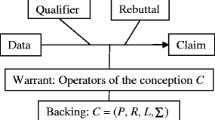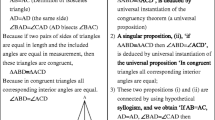Abstract
Students’ struggles in learning reasoning and proof (RP) in mathematics are well known. Despite the instantiation of RP opportunities in mathematics textbooks in the USA and the important role that textbooks play in teachers’ instructional decisions, little research has been conducted on analyzing student textbook tasks and narrative sections of mathematics textbooks in the USA. One polynomial functions unit located within a reform-oriented, conventional, and hybrid secondary mathematics textbook was examined for RP instances. RP tasks comprised 4, 9, and 22 % of the student tasks in the conventional, hybrid, and reform-oriented textbook units, respectively. The textbook exposition of all three textbook units promoted the presentation of proof building blocks (e.g., definitions) with no occurrences of conjecture development or testing. Overall, only 19 % of the learning objectives across the three textbook units were validated. The conventional and hybrid textbook units had the potential to promote an authoritative proof scheme in students while the reform-oriented textbook unit had the potential to promote an empirical proof scheme in students.






Similar content being viewed by others
Notes
Although this individual was an undergraduate prospective teacher I use the word “advanced” here to denote that she already possessed a master’s degree in economics.
Plausible patterns were not included here since there were no instances of these within PH and DA student tasks.
References
Balacheff, N. (1988). Aspects of proof in pupils’ practice of school mathematics. In D. Pimm (Ed.), Mathematics, teachers, and children (pp. 216–238). London: Hodder and Stoughton.
Bellman, A. E., Bragg, S. C., Charles, R. I., Hall, B., Handlin, W. G., & Kennedy, D. (2009). Prentice Hall mathematics: Algebra 2. Boston: Pearson.
Bieda, K. (2010). Enacting proof-related tasks in middle school mathematics: challenges and opportunities. Journal for Research in Mathematics Education, 41(4), 351–382.
Buchberger, B. (1990). Should students learn integration rules? ACM SIGSAM Bulletin, 24(1), 10–17.
Chazan, D. (1993). High school geometry students’ justification for their views of empirical evidence and mathematical proof. Educational Studies in Mathematics, 24(4), 359–387.
Common Core State Standards Initiative. (2010). Common core state standards for mathematics. Available from http://www.corestandards.org/assets/CCSSI_Math%20Standards.pdf. Accessed 6 December 2011
Education Development Center. (2009). Algebra 2. Boston: Pearson.
Edwards, T. G., & Ozgun-Koca, A. (2009). Creating a mathematics “b” movie: the effect of b on the graph of a quadratic. Mathematics Teacher, 103(3), 214–220.
Fey, J. T., & Hirsch, C. R. (2007). The case of core-plus mathematics. In C. R. Hirsch (Ed.), Perspectives on the design and development of school mathematics curricula (pp. 129–142). Reston: National Council of Teachers of Mathematics.
Fey, J. T., Hirsch, C. R., Hart, E. W., Schoen, H. L., Watkins, A. E., Ritsema, B. E., et al. (2009). Core-plus mathematics: contemporary mathematics in context: course 3 (2nd ed.). New York: Glencoe/McGraw-Hill.
Garry, T. (2003). Computing, conjecturing, and confirming with a CAS tool. In J. T. Fey, A. Cuoco, C. Kieran, L. McMullin, & R. M. Zbiek (Eds.), Computer algebra systems in secondary school mathematics education (pp. 137–150). Reston: National Council of Teachers of Mathematics.
Graham, K., Cuoco, A., & Zimmerman, G. (2010). Focus in high school mathematics: reasoning and sense making in algebra. Reston: National Council of Teachers of Mathematics.
Grouws, D. A., & Smith, M. S. (2000). Findings from NAEP on the preparation and practices of mathematics teachers. In E. A. Silver & P. A. Kenney (Eds.), Results from the seventh mathematics assessment of the national assessment of education progress (pp. 107–141). Reston: National Council of Teachers of Mathematics.
Halmos, P. R. (1980). The heart of mathematics. The American Mathematical Monthly, 87(7), 519–524.
Hanna, G., & de Bruyn, Y. (1999). Opportunity to learn proof in Ontario grade twelve mathematics texts. Ontario Mathematics Gazette, 37(4), 23–29.
Harel, G., & Rabin, J. M. (2010). Teaching practices associated with the authoritative proof scheme. Journal for Research in Mathematics Education, 41, 14–19.
Harel, G., & Sowder, L. (1998). Students’ proof schemes: results from exploratory studies. CBMS Issues in Mathematics Education, 7, 234–283.
Healy, L., & Hoyles, C. (2000). A study of proof conceptions in algebra. Journal for Research in Mathematics Education, 31, 396–428.
Heid, M. K., & Edwards, M. T. (2001). Computer algebra systems: revolution or retrofit for today’s mathematics classrooms? Theory Into Practice, 40, 128–136.
Herbst, P. (2002). Establishing a custom of proving in American school geometry: evolution of the two-column proof in the early twentieth century. Educational Studies in Mathematics, 49(3), 283–312.
Hiebert, J., Gallimore, R., Garnier, H., Givvin, K. B., Hollingsworth, H., Jacobs, J., et al. (2003). Teaching mathematics in seven countries: results from the TIMSS 1999 video study. Washington, DC: National Center for Education Statistics.
Johnson, G. J., Thompson, D. R., & Senk, S. L. (2010). Proof-related reasoning in high school textbooks. Mathematics Teacher, 103(6), 410–418.
Knuth, E. J., Slaughter, M., Choppin, J., & Sutherland, J. (2002). Mapping the conceptual terrain of middle school students’ competencies in justifying and proving. In S. Mewborn, P. Sztajn, D. Y. White, H. G. Wiegel, R. L. Bryant, & K. Nooney (Eds.), Proceedings of the 24th Meeting of the North American Chapter of the International Group for the Psychology of Mathematics Education (vol. 4, pp. 1693–1700). Athens, GA.
Landis, J. R., & Koch, G. G. (1977). The measurement of observer agreement for categorical data. Biometrics, 33, 159–174.
Lappan, G., Fey, J. T., Fitzgerald, W. M., Friel, S. N., Phillips, E. D. (1998/2004). Connected mathematics project. Menlo Park: Dale Seymour Publications.
Lindquist, M. M. (1997). NAEP findings regarding the preparation and classroom practices of mathematics teachers. In P. Kenney & E. A. Silver (Eds.), Results from the Sixth Mathematics Assessment of the National Assessment of Educational Progress (pp. 61–86). Reston: National Council of Teachers of Mathematics.
Martin, W. G., & Harel, G. (1989). Proof frames of preservice elementary teachers. Journal for Research in Mathematics Education, 20(1), 41–51.
Murdock, J., Kamischke, E., & Kamischke, E. (2002). Discovering algebra: an investigative approach. Emeryville: Key Curriculum Press.
Murdock, J., Kamischke, E., & Kamischke, E. (2004). Discovering advanced algebra: an investigative approach. Emeryville: Key Curriculum Press.
National Council of Teachers of Mathematics. (1989). Curriculum and evaluation standards for school mathematics. Reston: Author.
National Council of Teachers of Mathematics. (2000). Principles and standards for school mathematics. Reston: Author.
O’Keeffe, L. (2007). An analysis of the junior cycle mathematics textbooks. Unpublished dissertation, University of Limerick.
Researchware. (2009). Hyperresearch 2.8.3. [Computer Software.]. Randolph: ResearchWare, Inc.
Reys, B. J., & Reys, R. E. (2006). The development and publication of elementary mathematics textbooks: let the buyer beware! Phi Delta Kappan, 87(5), 377–383.
Schmidt, W. H., McKnight, C. C., & Raizen, S. A. (1997). A splintered vision: an investigation of U.S. science and mathematics education. Hingham: Kluwer.
Schoenfeld, A. H. (2009). Series editor’s foreword. In D. A. Stylianou, M. L. Blanton, & E. J. Knuth (Eds.), Teaching and learning proof across the grades: A K-16 perspective (pp. xii–xvi). New York: Routledge.
Senk, S. L. (1985). How well do students write geometry proofs? Mathematics Teacher, 78(6), 448–456.
Senk, S. L., & Thompson, D. R. (Eds.). (2003). Standards-based school mathematics curricula: what are they? What do students learn? Mahwah: Lawrence Erlbaum.
Silver, E. A., & Carpenter, T. P. (1989). Mathematical methods. In M. M. Lindquist (Ed.), Results from the fourth mathematics assessment of the National Assessment of Educational Progress (pp. 10–18). Reston: National Council of Teachers of Mathematics.
Stacey, K., & Vincent, J. (2009). Modes of reasoning in explanations in Australian eighth-grade mathematics textbooks. Educational Studies in Mathematics, 72, 271–288.
Stein, M. K., Remillard, J., & Smith, M. S. (2007). How curriculum influences student learning. In F. K. Lester Jr. (Ed.), Second handbook of research on mathematics teaching and learning (Vol. 1, pp. 319–370). Charlotte: Information Age Publishing.
Stylianides, A. (2007). Proof and proving in school mathematics. Journal for Research in Mathematics Education, 38(3), 289–321.
Stylianides, G. J. (2005). Investigating students’ opportunities to develop proficiency in reasoning and proving: A curricular perspective. Unpublished doctoral dissertation, University of Michigan.
Stylianides, G. J. (2009). Reasoning-and-proving in school mathematics textbooks. Mathematical Thinking and Learning, 11(4), 258–288.
Tarr, J. E., Reys, R. E., Reys, B. J., Chavez, O., Shih, J., & Osterlind, S. J. (2008). The impact of middle-grades mathematics curricula and the classroom learning environment on student achievement. Journal for Research in Mathematics Education, 39(3), 247–280.
Tinto, P. (1988). Students’ views on learning proof in high school geometry. Paper presented at the meeting of the American Educational Research Association, New Orleans.
Usiskin, Z., & Dossey, J. (2004). Mathematics education in the United States 2004: a capsule summary fact book written for the Tenth International Congress on Mathematics Education (ICME-10), Copenhagen, Denmark. Reston: National Council of Teachers of Mathematics.
Weiss, I. R., Banilower, E., McMahon, K., & Smith, P. S. (2001). Report of the 2000 National Survey of Science and Mathematics Education. Chapel Hill: Horizon Research.
Author information
Authors and Affiliations
Corresponding author
Rights and permissions
About this article
Cite this article
Davis, J.D. An examination of reasoning and proof opportunities in three differently organized secondary mathematics textbook units. Math Ed Res J 24, 467–491 (2012). https://doi.org/10.1007/s13394-012-0047-2
Received:
Revised:
Accepted:
Published:
Issue Date:
DOI: https://doi.org/10.1007/s13394-012-0047-2




